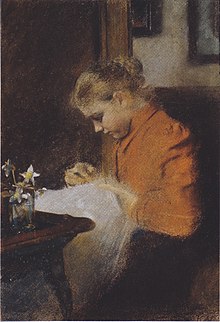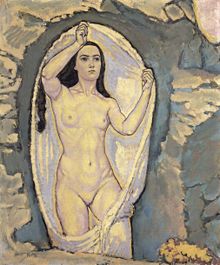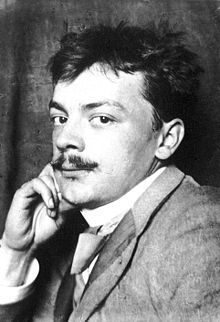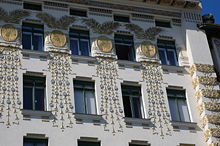Koloman Moser


Koloman Josef Moser (born March 30, 1868 in Vienna , Austria-Hungary ; died there October 18, 1918 ; also Kolo Moser ) was an Austrian painter , printmaker and craftsman .
Life
Kolo Moser was born in a building of the Theresianum , in the 4th district , Favoritenstraße 15. He was the son of Josef Moser, the administrator at the Vienna Theresianum, and his wife Theresia, née Hirsch. On April 4, 1868 he was baptized in the Paulanerkirche in Vienna- Wieden with the names Koloman and Josef . He had two younger sisters, namely Charlotte (July 2, 1869 - June 8, 1955) and Leopoldine (November 6, 1877 - July 13, 1957).
Koloman attended commercial school after primary school, and then he received regular drawing lessons at the Wieden trade school. He resisted his father's wish to take up a job in a Viennese soap and perfume shop. Instead, in 1885, he secretly registered at the Academy of Fine Arts in Vienna for the entrance exam, which he passed. From 1886 to 1889 he studied with Franz Rumpler , from 1889 to 1890 with Christian Griepenkerl and from 1890 to 1893 with Josef Mathias Trenkwald . After the death of his father, who had supported him, in 1888, Moser accepted numerous illustration commissions from art magazines such as Wiener Mode or Meggendorfer-Blätter to finance his advancement . On the recommendation of his teacher Josef Mathias Trenkwald, Moser became the drawing teacher of the children of Archduke Karl Ludwig of Austria at Wartholz Castle in Reichenau an der Rax for a year in 1892 . Moser's friendship with Carl Otto Czeschka , who was ten years his junior, dates from this time and to whom he passed on the position of drawing teacher at Wartholz Castle.
From 1892 to 1897 Moser was a member of the Club of Seven, which later became the Vienna Secession . From 1893 to 1895, Moser studied at the Kunstgewerbeschule under Franz von Matsch , where he also taught himself from 1899. In 1896 he was admitted to the cooperative of visual artists in the Vienna Künstlerhaus, but resigned after six months. During this time he worked on contributions to Martin Gerlach's portfolio Allegorien. New episode". In 1897 Moser was a co-founder of the Vienna Secession and won the competition to design the vignette for the letterhead. Through the Secession magazine, Ver Sacrum , he had a significant influence on the conception and design of the work and provided around 140 illustrations by 1903. In the years that followed, he took care of the events, exhibitions and organization of the Vienna Secession, sometimes alone and sometimes with other artists. When the Secession building was opened in November 1898, the facade decoration designed by Moser in the form of stylized owls, trees and the frieze of the wreath-bearers as well as the figural glass window in the entrance hall could be admired.
In the autumn of 1897, Moser undertook a journey via Munich, Nuremberg and Bamberg to Leipzig, Dresden and Prague. In between, he worked on the design of female portrait medallions as allegories of the virtues, which were intended for the residential and commercial building designed by the architect Otto Wagner , which was completed in 1898 . He also made several drafts for textile design for the Austrian company Joh. Backhausen & Sons - a renowned textile manufacturer. In those years Kolo Moser was mainly active in arts and crafts. Further drafts of a figural glass window for Josef Hoffmann's business premises and drafts for the glass design of the Imperial and Royal purveyor E. Bakalowits & Sons followed in 1899. He was supported by the Scottish artist couple Charles Rennie Mackintosh and Margaret MacDonald Mackintosh , who were exhibiting in the Vienna Secession, and the English Arts & Crafts movement influenced. In 1899 Moser again traveled to Prague, Dresden and also Berlin . In 1900 he drove to the Paris World Exhibition via Munich and Strasbourg . In 1901 he visited the Bohemian glass factories in Klostermühle and Winterberg together with Ludwig Bakalowits and traveled to Dresden with Carl Moll .
His appointment as professor for decorative drawing and painting at the Kunstgewerbeschule in 1900 was a logical step in recognition of his previous artistic work. In addition to his teaching activities and the promotion of young artists, the next few years were also very much characterized by manual and creative tasks. He produced a series of furniture designs for the furniture and interior design company Portois & Fix , provided design designs for the renowned Viennese porcelain manufacturer Josef Böck and in 1901 made a figural glass window for the Hotel Bristol in Warsaw. He also acquired further commissions in the Viennese theater sector. In 1901 he provided designs for stage sets, costumes, posters and programs for Felix Salten 's "Jung-Wiener Theater".
In 1902, Moser, his mother and sister moved into the residential studio built by Josef Hoffmann on the Hohe Warte in Vienna's 19th district, Steinfeldgasse 8, where Moll also lived. Moser furnished the apartment according to his own designs. In the summer he traveled to Abbazia , Lovran , Trieste , Venice and Padua . Furniture designs for the Prag-Rudniker basketry factory and the bentwood company Jacob & Josef Kohn followed, together with Josef Hoffmann, the design of the villa of the textile entrepreneur Fritz Warndorf. In 1903, Josef Hoffmann founded the Wiener Werkstätte together with Kolo Moser and the industrialist Fritz Wärndorfer . The aim of this was to promote handicrafts over industrial production. Furniture, jewellery, leather and metal work, toys, book covers and other art-related works were made there according to designs by Kolo Moser. For the workshop itself he designed two figural glass windows "Rain and Sunshine". In the summer Moser traveled again with Moll via Munich to Bern , where he met Ferdinand Hodler and Cuno Amiet for the first time , Basel , Paris , Bruges , Scheveningen, Antwerp, Lübeck and Hamburg. In 1904 he went with his future wife Ditha (1883-1969) and her mother Editha Mautner von Markhof (1846-1918) to Riva on Lake Garda, to Verona and Venice. In September he was in Berlin, where he designed the first Wiener Werkstätte exhibition.
In 1905 Moser left the Vienna Secession with the Klimt group. On July 1, 1905, he married the wealthy industrialist's daughter Ditha Mautner von Markhof and changed his religion because of this marriage. The Mautner Markhofs were multi-denominational. The honeymoon took the young couple to Hallstatt and St. Gilgen in the Salzkammergut to Carl Moll. Moser moved from his house on the Hohe Warte to an apartment in the garden wing of the Palais Mautner Markhof at Landstraßer Hauptstraße 138, which he also furnished according to his own designs. The young family often stayed at the Mautner Markhofs' villa on the Semmering . On August 21, 1906 the eldest son Karl († February 26, 1976) was born. In November of the same year the stamp series for Bosnia-Herzegovina designed by Moser appeared . In 1907 Moser left the Wiener Werkstätte because of differences with Fritz Wärndorfer and since then has started to devote more time to painting. In the summer he traveled to Venice and Padua again, and in 1908 he also went to Venice together with his wife and Hermann Bahr . On July 1, 1909, the second son Dietrich was born, who died at the age of almost 16 on June 21, 1925.
He received a first prize in 1907 for his design for the painting of the Heilig-Geist-Kirche in Düsseldorf. However, this order was not carried out. The following year he brought a plagiarism trial against the painter Carl Ederer at the Vienna court . After he changed his denomination in 1905, the commissioned prelate Heinrich Swoboda withdrew his commission to decorate the high altar in the church at Steinhof in Vienna. Since Carl Ederer's draft was almost identical to the draft submitted by Moser and discussed with the head of the church, he had filed a lawsuit. The trial then ended with a settlement and an apology from Moser, referring to "ignorance of the circumstances". In 1908 Moser took part in the Vienna Art Show organized by the Klimt Group , in 1909 in the International Art Show in Vienna and in the Exhibition of Christian Art in Düsseldorf. In 1911 he had his only solo exhibition at the Miethke Gallery in Vienna and also took part in the International Art Exhibition in Rome . In the same year he designed a series of stamps and correspondence cards for the 60th anniversary of the reign of Emperor Franz Josef I. Orders to design costumes for the Viennese cabaret Fledermaus, suggestions for the artistic design of the 100-kroner banknote, the equipment for the performance of the opera "The Musician" by Julius Bittner followed. In 1912 he went to Lake Garda and South Tyrol and took part in the Great Art Exhibition in Dresden. When he took his son Dietrich to a sanatorium in Switzerland in 1913, he met Ferdinand Hodler again in Geneva , who was to exert a great influence on Moser's painting. Another visit to Venice was followed by participation in exhibitions at the 1st International Secession Exhibition in Rome, the Great Art Exhibition in Düsseldorf and the Scene Art Exhibition in Mannheim . In 1916 he exhibited at the Vienna Art Show in Berlin and became a member of the Deutscher Künstlerbund .
In 1916 Moser fell ill with throat cancer. Correspondence with Alfred Roller shows that he himself was thinking about his successor at the Kunstgewerbeschule while he was still in bed . Adolf Michael Boehm only headed the “Moser class” on an interim basis. After Johannes Itten was rejected , the Munich painter Wilhelm Müller-Hofmann was appointed by Alfred Roller to take Moser's place on October 1, 1919.
Kolo Moser died on October 18, 1918. He was buried on October 21 in the Hietzing Cemetery (location of the grave: group 16 - 14D).
afterlife
The Kolo-Moser-Gasse in Vienna - Donaustadt was named in his honor in 1969. There is a commemorative plaque on his former home at Landstrasser Hauptstrasse 138.
In 1989 the Austrian 500-schilling commemorative coin Koloman Moser appeared in silver with his portrait on the obverse, designed by Herbert Wähner. The reverse features Koloman Moser's 1898 stained glass window of the Great Hall of the Secession building in Vienna , which was destroyed during World War II; therefore only the draft in watercolor and ink was available. This design symbolizes "Art" in the form of a winged female genius, it is now owned by the Austrian Museum of Applied Arts.
On the occasion of the 100th anniversary of his death in 2018, the Museum of Applied Arts Vienna paid tribute to Koloman Moser with one of the most extensive personal tributes to date (December 19, 2018–April 22, 2019).
factories



Kolo Moser was one of the most important artists in Vienna at the turn of the 19th and 20th centuries. He is one of the leading representatives of Art Nouveau . His painting was initially influenced by Impressionism , but later he was entirely under the influence of Ferdinand Hodler . Moser's activity as a craftsman was particularly varied. In this field, he made particularly important contributions with his decorative and witty two-dimensional designs. But he also had a playful imagination, as can be seen, for example, in marbled papers , in which he, together with Josef Hoffmann and Leopold Stolba, discovered or hid the figures of lizards and turtles in the sense of blobography , so that coincidence and imagination create a special game.
The largest public Moser collection, including a large number of paintings and handicrafts, is in Vienna's Leopold Museum in the Museum Quarter; a large part of it is permanently shown in the permanent exhibition "Vienna 1900". The library and worksheet collection of the Museum of Applied Arts (Vienna) also has around 700 drawings by the important Art Nouveau artist, the stock of which was recorded in a database in 2008 and compared with the information from the magazines "Ver Sacrum" and "Jugend treasure of German poetry".
painting
- Semmering landscape with viaduct (Zug, Kunsthaus Zug , inv. no. KG 209), 1907, oil on canvas, 100.5 × 50.5 cm
- View of the Rax (Vienna, Leopold Museum, inv. no. 687), oil on canvas
- Yellow house in front of a mountain (Vienna, Leopold Museum, inv. no. 577), oil on canvas
- Marigolds (Vienna, Leopold Museum, inv. no. 151), oil on canvas
- Girl with a necklace (Vienna, Leopold Museum, inv. no. 150), oil on canvas
- Primroses in a basket (Vienna, Leopold Museum, inv. no. 580), oil on canvas
- Nasturtium (private collection), 1910, oil on canvas
- Blossoming tree in the garden (private collection), 1910, oil on canvas, 50.5 × 50.5cm
- Flower stick and ceramic jug (Vienna, Leopold Museum, inv. no. 579), 1912, oil on canvas, 50 × 50 cm
- Female back nude (Vienna, Leopold Museum, inv. no. 581), 1912/14, oil on canvas
- The Rax (Vienna, Leopold Museum, inv. no. 96), around 1913, oil on canvas
- Lake Wolfgang with a high horizon (Vienna, Leopold Museum, inv. no. 89), around 1913, oil on canvas
- Lake Wolfgang with a low horizon (Vienna, Leopold Museum, inv. no. 90), around 1913, oil on canvas
- The love potion - Tristan and Isolde (private ownership), 1913/15, oil on canvas
- Venus in the Grotto – Study (Vienna, Leopold Museum, Inv. No. 583), 1914/15, oil on canvas, 75.5 × 62.7 cm
- Venus in the Grotto (Vienna, Leopold Museum, Inv. No. 1999), oil on canvas
- Wotan and Brünhilde (Vienna, Leopold Museum, inv. no. 585), 1914/15, oil on canvas, 50.2 × 75.3 cm
- The Wanderer (Vienna, Leopold Museum, inv. no. 584), 1914/15, oil on canvas, 75.5 × 62.5 cm
- Chestnut blossoms (Vienna, Leopold Museum, inv. no. 631), 1915/16, oil on canvas
- Judith and Holofernes (Vienna, Leopold Museum, inv. no. 578), 1916, oil on cardboard
graphic
- Moser collaborated on the magazines Ver Sacrum , Wiener Mode and Meggendorfer's humoristic sheets .
- In 1906 he designed the Austrian stamp issue for Bosnia-Herzegovina (also 1912) and in 1908 the Emperor Franz Joseph anniversary stamp issue on the occasion of the diamond jubilee of Emperor Franz Joseph , as well as the Austro-Hungarian military stamps of 1915 and the first stamps for Liechtenstein (1912– 1918).
- book illustrations
- 100 kroner banknote , issued in 1910
- posters
- Jubilee postcard for Emperor Franz Joseph I, 1908 (engraved by Ferdinand Schirnböck )
handicrafts
- fashion designs
- Glass service for the company Bakalowits
- Lamps and furniture designs for the Wiener Werkstätte , e.g. B. the furniture series The Rich Draft of Fish .
- Stained glass window for the Vienna Secession building Die Kunst (destroyed in World War II)
- High altar and stained glass window for the church at Steinhof built by Otto Wagner , 1904–1905 digi.ub.uni-heidelberg.de
- Draft for the angel window in the Otto Wagner Church at Steinhof (Vienna, Leopold Museum, Inv.Nr. 5270), 1905, gouache on paper
- Decorations at Linke Wienzeile 38 by Otto Wagner
- Stage decorations for dramas and operas
- Stained glass window for the " Narodni Dom " building in Trieste
literature
- Stefan Üner: Koloman Moser. The Photographic Eye, in: PhotoResearcher , No 31, Vienna 2019, pp. 134–147.
- Christoph Thun-Hohenstein (ed.), Christian Witt-Dörring (ed.), Elisabeth Schmuttermeier (ed.): Koloman Moser. Universal artist between Gustav Klimt and Josef Hoffmann , exhibition catalog MAK, Vienna 2019, ISBN 978-3-0356-1849-5
- Stefan Üner: The art of presentation. Koloman Moser as exhibition designer, in: Parnass , 4/2018, pp. 22-24.
- Gerd Pichler: Moser, Koloman . In: General Artist Lexicon . The visual artists of all times and peoples (AKL). Volume 91, de Gruyter, Berlin 2016, ISBN 978-3-11-023257-8 , p. 48 f.
- Stefan Üner: The art of presentation. Koloman Moser as exhibition designer . Dissertation. University of Applied Arts Vienna, Vienna 2016.
- Koloman Moser: surface decoration . Gerlach, Vienna 1902.
- Gertrud Pott: The Reflection of Secessionism in the Austrian Theater . Published by the Institute for Theater Studies at the University of Vienna. Publisher Wilhelm Braumüller, Vienna/Stuttgart 1975.
- Werner Fenz : Koloman Moser - graphics, applied arts, painting . Residenz-Verlag, Salzburg/Vienna 1984, ISBN 3-7017-0369-8 .
- Maria Pötzl-Malikova: Moser, Koloman. In: New German Biography (NDB). Volume 18, Duncker & Humblot, Berlin 1997, ISBN 3-428-00199-0 , pp. 198–200 ( digitized ).
- Maria Rennhofer: Koloman Moser . Brandstätter, Vienna 2002, ISBN 3-85498-123-6 .
- Rudolf Leopold, Gerd Pichler (eds.): Koloman Moser 1868-1918. Catalog for the exhibition in the Leopold Museum, Vienna. Prestel, Munich 2007, ISBN 978-3-7913-3868-2 .
- Anita Kern, Bernadette Reinhold, Patrick Werkner (eds.): Graphic design from Viennese modernism to the present day. From Kolo Moser to Stefan Sagmeister. From the collection of the University of Applied Arts Vienna . Springer Verlag, Vienna 2010.
- Gerd Pichler: Koloman Moser. The paintings - catalog raisonné. W & K Edition, Vienna 2012, ISBN 978-3-200-02673-5 .
- German Art and Decoration . 1907, pp. 167-205, About the Church at Steinhof in Vienna.
- R. Leopold, G. Pichler: Koloman Moser 1868-1918. Munich 2007, ISBN 978-3-943616-49-1 .
- Christian Dörring-Witt (ed.): Koloman Moser. Designing modern Vienna 1897-1907. Munich 2013, ISBN 978-3-7913-5294-7 .
web links
- Digital MAK: Works by Koloman Moser
- Koloman Moser as a painter – Lecture by Stefan Üner
- Literature by and about Koloman Moser in the German National Library catalogue
- Entry on Koloman Moser in the Austria-Forum (in the AEIOU -Austria-Lexicon )
- Entry on Koloman Moser in the state memory database on the history of the state of Lower Austria ( Lower Austria Museum )
- Works by Koloman Moser at Zeno.org
- District Museum Landstrasse – Kolo Moser on the Landstrasse
itemizations
- ↑ Digitized
- ↑ Charlotte Moser, sister of the artist , at Belvedere
- ↑ Leopoldine married Rudolf Steindl (April 13, 1871 – September 14, 1953), who was portrayed twice by Kolo Moser. Both had two children, Elisabeth (?-?) Digitalisat and Josef Steindl (* April 14, 1912; † March 7, 1993)
- ↑ House Moll-Moser - Vienna History Wiki. Retrieved January 13, 2019 .
- ↑ born Freiin Sunstenau von Schützenthal
- ↑ Address: Semmering 74 - near the Wolfsbergkogel and the Südbahnhof. The house was built in 1901 by the Austrian architect Franz Neumann (1844-1905). Later it was called "Haus Adelmann".
- ↑ kuenstlerbund.de: Ordinary members of the Deutscher Künstlerbund since it was founded in 1903 / Moser, Koloman ( Memento des Originals from March 4, 2016 in the Internet Archive ) Info: The archive link was inserted automatically and has not yet been checked. Please check the original and archive link according to the instructions and then remove this notice. , at Künstlerbund (accessed November 18, 2015)
- ↑ mak library and worksheet collection - u:scholar
- ↑ mak.at
- ↑ Rudolf Leopold, Gerd Pichler (eds.): Koloman Moser 1868-1918. Catalog for the exhibition in the Leopold Museum, Vienna. Prestel, Munich 2007, p. 426 f.
- ↑ Schilling coins of the Austrian National Bank ( Memento des Originals from February 2, 2014 in the Internet Archive ) Info: The archive link was inserted automatically and has not yet been checked. Please check the original and archive link according to the instructions and then remove this notice. p. 34 (PDF).
- ↑ 500 Schilling Koloman Moser in Austria-Forum .
- ↑ Sketch for the Round Window The Art , at Wikipaintings.
- ↑ Koloman Moser: universal artist between Gustav Klimt and Josef Hoffmann. MAK – Museum of Applied Arts, Vienna, accessed November 23, 2018 .
- ↑ Michael Pabst: Viennese graphics around 1900. Verlag Silke Schreiber, Munich 1984, pp. 173-190.
| personal data | |
|---|---|
| SURNAME | Moser, Koloman |
| ALTERNATIVE NAMES | Moser, Kolo |
| BRIEF DESCRIPTION | Austrian painter, graphic artist and craftsman |
| BIRTH DATE | March 30, 1868 |
| PLACE OF BIRTH | Vienna |
| DATE OF DEATH | October 18, 1918 |
| PLACE OF DEATH | Vienna |




